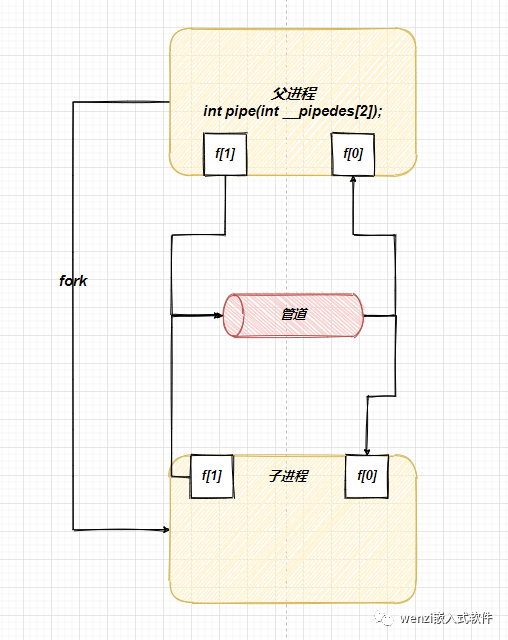概述
管道是 UNIX系统 IPC的最古老的形式,所有的UNIX系统都提供此种通信。所谓的管道,也就是内核里面的一串缓存,从管道的一段写入的数据,实际上是缓存在内核中的,令一端读取,也就是从内核中读取这段数据。对于管道传输的数据是无格式的流且大小受限。对于管道来说,也分为匿名管道和命名管道,其中命名管道也被叫做 FIFO,下面则分别阐述这两种管道。
匿名管道
默认情况下,在 Shell命令执行过程中,任何一个命令都有一个标准输入设备(键盘)、标准输出设备(显示器)和标准输出设备(显示器),使用管道"|"可以将两个命令连接起来,从而改变标准的输入输出方式,下面是在 Linux 端运行命令行的一个截图:
上述命令中的意思也就是,将ls命令得到的结果作为 grep tags命令的输入。
连接输入输出的中间设备即为一个管道文件,综上,也就是说使用管道可以将一个命令的输出作为另一个命令的输入(在运行的时候,一个命令将创建一个进程),而这种管道是临时的,命令执行完毕之后就会自动消失,这类管道称为无名管道。
匿名管道例子
匿名管道在使用前要先创建,其函数的声明如下:
- extern int pipe (int __pipedes[2]);
此函数的参数是一个整型数组,如果执行成功,pipe 将存储两个整型文件描述符于__pipedes[0]和__pipedes[1]中,他们分别指向管道的两端。如果系统调用失败,则返回 -1。
读无名管道,该函数的声明如下:
- extern ssize_t read (int __fd, void *__buf, size_t __nbytes);
第一个参数fd为打开的文件描述符,buf为读出数据的存储位置,nbytes为读取数据的大小,调用 read 函数将从 fd 指向的文件描述符指定的打开文件中宏读 n 字节到 buf 指向的缓冲区内。
如果试图向已经填满的管道写入,系统会自动阻塞。一个管道不能同时被两个进程打开。
- extern ssize_ t write(int __fd, __const void *__buf, size_t __n);
从 buf指向的缓冲区中向管道中写入nbytes字节,且每次写入的内容都附件在管道的末端。
那要如何使用管道在两个进程之间通信呢,我们可以使用 fork()创建子进程,创建的子进程会复制父进程的文件描述符,这样就做到了两个进程各有两个fd[0]与fd[1],两个进程就可以通过各自的fd写入和读取同一个管道文件实现进程通信了,具体原理如下所示:
具体的例子如下所示:
- #include<unistd.h>
- #include<stdio.h>
- #include<stdlib.h>
- int main(int argc, char *argv[])
- {
- pid_t pid;
- int temp;
- int pipedes[2];
- char s[14] = "test message!";
- char d[14];
- if (pipe(pipedes) == -1) // 创建管道
- {
- perror("pipe");
- exit(EXIT_FAILURE);
- }
- if (pid == fork() == -1)
- {
- perror("fork");
- exit(EXIT_FAILURE);
- }
- else if (pid == 0) // 子进程
- {
- printf("now,write data to pipe\n");
- if (write(pipedes[1], s, 14) == -1) // 写数据到管道
- {
- perror("write");
- exit(EXIT_FAILURE);
- }
- else
- {
- printf("the written data is:%s\n",s);
- exit(EXIT_SUCESS);
- }
- }
- else if (pid > 0) // 父进程
- {
- slepp(2);
- printf("now, read from pipe\n");
- if ((read(pipedes[0], d, 14)) == -1)
- {
- perror("read");
- exit(EXIT_FAILURE);
- }
- printf("the data from pipe is:%s\n",d);
- }
- return 0;
- }
代码运行的结果如下所示:
命名管道
命名管道又被称之为是 FIFO ,未命名的管道只能在两个相关的进程之间使用,而且这两个相关的进程还要又一个共同创建了他们的祖先进程,但是,通过 FIFO ,不相关的进程也能交换数据。
首先,介绍下是如何创建命名管道的:
- extern int mkfifo (__const char *__path, __mode_t __mode);
mkfifo会根据参数建立特殊的有名管道文件,该文件必须不存在,而参数mode为该文件的权限。
下面是一个使用命名管道进行进程间通信的例子,例子分为两个程序,分别是读部分和写部分,首先看先往管道写数据的代码,代码如下所示:
- #include <stdio.h>
- #include <string.h>
- #include <fcntl.h>
- #include <sys/stat.h>
- #include <sys/types.h>
- #include <unistd.h>
- int main()
- {
- int fd;
- // FIFO file path
- char * myfifo = "/tmp/myfifo";
- // Creating the named file(FIFO)
- // mkfifo(<pathname>, <permission>)
- mkfifo(myfifo, 0666);
- char arr1[80], arr2[80];
- while (1)
- {
- // Open FIFO for write only
- fd = open(myfifo, O_WRONLY);
- printf("The fd is:%d\n",fd);
- // Take an input arr2ing from user.
- // 80 is maximum length
- fgets(arr2, 80, stdin);
- // Write the input arr2ing on FIFO
- // and close it
- write(fd, arr2, strlen(arr2)+1);
- close(fd);
- // Open FIFO for Read only
- fd = open(myfifo, O_RDONLY);
- // Read from FIFO
- read(fd, arr1, sizeof(arr1));
- // Print the read message
- printf("User2: %s", arr1);
- close(fd);
- }
- return 0;
- }
然后是先往管道读数据的代码,代码如下所示:
- #include <stdio.h>
- #include <string.h>
- #include <fcntl.h>
- #include <sys/stat.h>
- #include <sys/types.h>
- #include <unistd.h>
- int main()
- {
- int fd1;
- // FIFO file path
- char * myfifo = "/tmp/myfifo";
- char str1[80], str2[80];
- while (1)
- {
- // First open in read only and read
- fd1 = open(myfifo,O_RDONLY);
- printf("The fd is:%d\n",fd1);
- read(fd1, str1, 80);
- // Print the read string and close
- printf("User1: %s", str1);
- close(fd1);
- // Now open in write mode and write
- // string taken from user.
- fd1 = open(myfifo,O_WRONLY);
- fgets(str2, 80, stdin);
- write(fd1, str2, strlen(str2)+1);
- close(fd1);
- }
- return 0;
- }
下面是代码运行的一个结果:
说明一下,就是说当运行 write程序的时候,会创建fifo文件,命名管道,然后,在 write文件中就执行open操作,但是,这里存在的一个问题就是,因为在运行 write程序的时候,没有进程打开读端,也就阻塞了 open函数的运行,只有运行read操作,以读的方式读取管道的数据,这样才能使得write中的open函数继续执行。
综上,也就是命名管道在进程中通信的一个例子。
小结
上述就是本次进程通信中关于管道的相关内容,其中就包括匿名管道以及命名管道,他们之间存在着差别吗,也各有各的应用,本次的分享就到这里啦~
本文转载自微信公众号「wenzi嵌入式软件」,可以通过以下二维码关注。转载本文请联系wenzi嵌入式软件公众号。





































